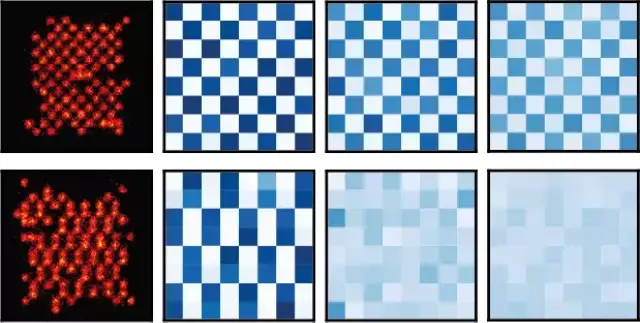6 February 2025
Quantum spaces shatter under strong interactions
A quantum simulator with neutral atoms confirms surprising properties of thermalisation in two-dimensional quantum systems.
In the quantum world, thermodynamic processes do not always unfold as expected. A research team at the Max Planck Institute of Quantum Optics (MPQ) has demonstrated this using a quantum simulator with neutral atoms. In their experiment, the scientists placed 200 atoms in an optical lattice and arranged them in different patterns. While some configurations remained stable for a long time, others dissolved quickly. Unlike in classical systems, the initial state significantly determined the thermalization behaviour. The study shows how strong interactions and motional constraints of the atoms affect the behaviour of quantum systems and profoundly influence their dynamics. The results, published in Nature, confirm theoretical predictions and provide new insights into the relaxation behaviour of quantum systems out of equilibrium.
Quantum systems consisting of many particles are extremely complex. This is due to the exponentially growing number of configurations that such a system can simultaneously adopt. On the one hand, this complexity drives the computational power of quantum computers. On the other, it ensures that quantum systems initially pushed out of equilibrium eventually return to it – regardless of their initial state. This phenomenon is called thermalisation. A common everyday example is an ice cube melting in a drink: After a while, the melted water mixes completely with the liquid, and the original shape of the ice – cube or crushed – makes no difference.
In the quantum world, however, these rules can be overridden, as a new experiment in a quantum simulator with neutral atoms demonstrates. The study focused on a strongly interacting gas of bosonic atoms trapped in so-called optical lattices – light crystals created by interfering laser beams. The researchers realised a variant of the 2D Bose-Hubbard model, which is used to investigate the thermodynamic processes in quantum many-body theory. The breakthrough came by slightly modifying this model: an additional potential was applied to the atoms, causing the system to tilt to one side. This energy imbalance between neighbouring lattice sites restricted the movement of the atoms and prevented them from reaching equilibrium.
The team found that the relaxation behaviour depended strongly on the initial conditions. In some cases, the atoms remained in their original positions, while in others, they returned to equilibrium. Theorists had already predicted this behaviour: depending on how the atoms were initially arranged, the systems displayed entirely different thermalisation properties. The explanation lies in the Hilbert space—an abstract mathematical framework used to describe quantum systems. Under certain conditions, this space fragments into smaller, isolated units. Once a quantum system is initially confined within one of these fragments, it can no longer escape—a phenomenon known as Hilbert space fragmentation (HSF).
Atoms in Traffic Jams

The quantum system behaved quite differently in the case of an initial "dimer" pattern where two atoms occupy neighbouring positions. In this case, the atoms quickly abandoned their initial arrangement and instead formed a regular pattern, indicating the approaching thermalised state. "This case can be compared to a traffic jam where small gaps gradually open," explains Daniel Adler further. "Once the first car starts moving, other vehicles can gradually follow one by one until traffic flows evenly."
The Strange World of Fractons
The team also investigated the dynamics of defects in the chequerboard pattern – systems where a single atom was displaced from its original position in the lattice. These defects exhibited so-called fractonic behaviour. The term derives from "fractional" and describes highly restricted movement patterns where atoms can only act along specific pathways – much like a bishop on a chessboard.
"Our experiment is the first comprehensive investigation of Hilbert space fragmentation in two-dimensional systems and shows the profound influence of kinetic constraints on the thermalisation properties of certain initial states in quantum many-body systems," comments research group leader Johannes Zeiher. The work opens up exciting possibilities for future studies exploring the exotic and dynamic evolution of quantum systems out of equilibrium. One possible research area is the more precise quantitative characterisation of the transport behaviour of defects and the precise determination of the nature of Hilbert space fragmentation. Such studies could shed new light on classically unexpected behaviour in the microscopic quantum world.
Article originally published on
MPQ website.
Publication
Observation of Hilbert space fragmentation and fractonic excitations in 2D
Adler, D., Wei, D., Will, M., Srakaew, K., Agrawal, S., Weckesser, P., Moessner, R.,
Pollmann, F.,
Bloch, I. &
Zeiher, J.
Nature 636, 80– 85 (2024)
DOI:
10.1038/s41586-024-08188-0